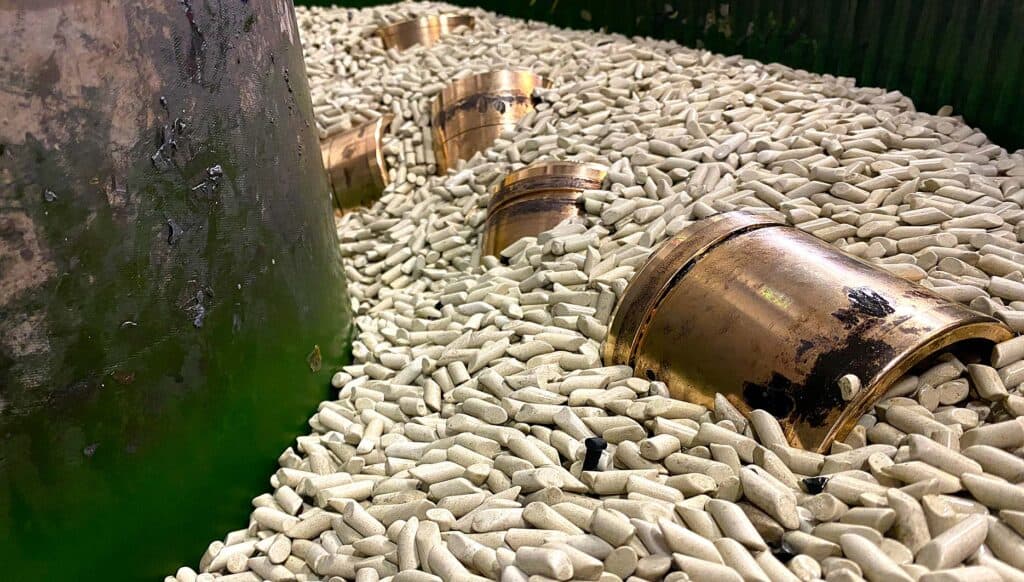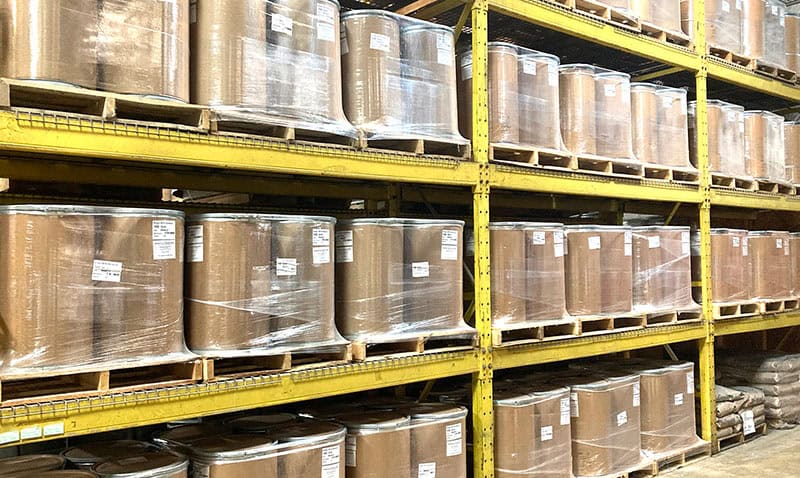Part Three
 Welcome back to part 3 of our “Accelerating Vibratory Finishing” series, where we address frequently asked questions about vibratory deburring and polishing. If you’re new to the series, feel free to check out our previous blogs on proper vibratory media levels, setup, and troubleshooting of your vibratory bowl. Today, we’ll explore the best methods for unloading your parts from the vibratory finishing process and discuss how your unloading technique can affect the overall process and finish.
Welcome back to part 3 of our “Accelerating Vibratory Finishing” series, where we address frequently asked questions about vibratory deburring and polishing. If you’re new to the series, feel free to check out our previous blogs on proper vibratory media levels, setup, and troubleshooting of your vibratory bowl. Today, we’ll explore the best methods for unloading your parts from the vibratory finishing process and discuss how your unloading technique can affect the overall process and finish.
Over the years, I’ve often seen operators unload parts manually by hand-picking them out of the vibratory finisher. While this method may be used out of necessity or convenience, it can negatively impact the finish quality and introduce inconsistencies into the process. In many cases, I find that operators have limited knowledge about the process, including details like the number of parts per run, cycle times, and the amounts of water and compound used. It’s not that they haven’t developed a proper finishing process, but rather that the process has evolved based on the types of parts being finished and the production demands they need to meet.
Manually unloading parts can be efficient when working with a small bowl and a limited volume of parts. However, as you move beyond 1 cubic foot capacity bowls and increase the number of parts per run, this manual method can significantly compromise the consistency of both the finish and the process. Here are some of the negative impacts of manual unloading that we commonly encounter:
Low Media Levels
In the first blog of this series, we discussed media levels, but it’s worth revisiting due to its frequent occurrence. Many operators aim to process parts quickly through the vibratory finisher, but eventually, they find it challenging and time-consuming to locate parts when the bowl is full. This often leads them to reduce the amount of media in the finisher. Typically, they don’t adjust the number of production parts per cycle, as their goal is to expedite the work. This reduction in media alters the part-to-media ratio, potentially extending cycle times and increasing the risk of part-on-part contact, which can cause damage. When the finishing process was initially developed, the part-to-media ratio was likely a critical factor in determining the maximum number of parts per cycle to prevent such damage.
Quick Tip – When unloading parts by hand, always keep the vibratory process running. This makes it much easier to sift through the media and locate your parts. We’ve tried turning the machine off before, and trust me, it’s a lot more difficult!
Additionally, if your unloading process takes 10 minutes while your cycle times are set to 20 minutes, the parts unloaded first will complete the full 20-minute cycle, whereas those unloaded last may be tumbled for up to 30 minutes. This variation can be a major issue if you need to maintain precise tolerances or are dealing with delicate parts.
Additionally, lowering media levels to make unloading easier can interfere with the proper rolling effect of the vibratory finisher. Insufficient media leads to inadequate coverage, causing parts to be poorly surrounded or agitated, which can result in uneven deburring or polishing. The key advantage of vibratory deburring and polishing is its ability to automate the finishing process, delivering consistent results as long as the starting conditions are uniform.
There isn’t a one-size-fits-all method for unloading your vibratory finisher, but the primary goal is to maintain consistency with the variables of your established process. I understand this can be challenging, especially when working with older equipment that lacks modern unloading options. That being said, we will present a few unloading options utilized by our customers and even employed in our own deburring and polishing job shop.
Manual – Hand Removal:
While we’ve already addressed the challenges associated with this method, there are situations where it may be your only option. In our process development lab, we test parts using a small CLM VibeTech vibratory finisher with a capacity of about 1 cubic foot. This method works well for us, provided we’re not processing large volumes of very small parts. However, when working with larger-capacity finishers, I recommend avoiding this approach unless absolutely necessary. Manually unloading parts can disrupt the consistency of the process and may lead to larger issues, such as quality rejects.
Internal Separation Upgrades:
When purchasing a new vibratory system (we recommend the CLM VibeTech Systems), you’ll often have the option for internal separation, which includes features like manual unload gates and pneumatic gates. These systems allow parts to be separated from the media inside the machine before unloading. Essentially, a gate inside the bowl rises to meet a screen deck, and the media pushes the parts up the gate and onto the deck. The vibratory media then falls through the screen and returns to the bowl, while the parts are separated and ready for removal.
Manual unload gates are a simple and cost-effective solution, allowing operators to control the release of parts by physically opening and closing the gate. While this option works well for smaller operations or less frequent unloading, it can be labor-intensive and slow. Pneumatic unload gates, on the other hand, offer a more automated and efficient approach. Powered by air pressure, these gates can be opened and closed quickly with minimal effort, improving throughput and consistency in larger operations. Pneumatic gates are especially useful for high-volume processes where speed and precision are key.
Magnetic Separation:
Magnetic unloading is an efficient and effective method for separating ferrous parts from the media in a vibratory bowl. This system uses magnets to attract and hold the parts, allowing them to be easily removed from the bowl while leaving the media behind. The magnetic separation process is particularly useful for applications involving metal parts, as it streamlines the unloading process and reduces the risk of media contamination. Once the parts are lifted out by the magnet, they can be transferred for further processing, while the media stays in the bowl for reuse.
Quick Tip – When processing parts in smaller finishers, we use a magnetic baton to retrieve the parts. This method helps maintain media levels while allowing for quick and efficient unloading of parts.
Shaker Screeners:
Shaker screeners are the go-to solution when you need to separate both parts and media after they’ve been unloaded from a batch finisher. They’re perfect for applications where separating parts from media is a must, or when you need to classify media offline. Powered by twin electric vibratory motors, these machines use linear motion and vibration to move the entire mass forward while creating just enough vertical action to assist with the separation process. In most setups, the media or screened material is funneled down to a lower level, moved to the end of the machine, and then expelled through a discharge chute into the customer’s media bin or hopper. It’s an efficient, hands-off way to get the job done!
Qucik Tip – Many processes require specific sizes and shape of media to prevent it from getting lodged in the parts. A shaker screener can help by removing small media pieces from your working mix. This not only saves time and money but also ensures that vibratory media doesn’t get trapped in opening in your parts.
So, there you have it! Whether you’re manually unloading parts or using the more advanced method of internal separation systems, the key is to keep things consistent and efficient. Remember, unloading isn’t just about getting the parts out of the vibratory bowl; it’s about doing so in a way that maintains the quality and consistency of your process. From magnetic unloading to shaker screeners, there’s a solution for every need. And while the manual method might still have its place in smaller operations, as you scale up, it’s time to leave that hand-picking behind. Because let’s be honest, unloading parts shouldn’t feel like a game of “Where’s Waldo?” in a sea of media. Get the right method, save time, reduce mistakes, and keep your process humming along smoothly. Until next time, happy finishing!
If you’re looking to develop a deburring or polishing process, or if you already have one and need the right media, compound, or equipment, get in touch with Rodeco Metal Finishing. Our process development lab leverages decades of testing and finishing expertise to create a tailored solution that enhances the quality, consistency, and efficiency of your parts
Need to replenish your media supplies?
We carry a large supply of media that is ready to ship out today.
Call us at 919-775-7149
or visit Blast Media to find out more.

Give us a call at 919-775-7149! We’d love to chat about how we can take care of all your Metal Finishing needs, allowing you to concentrate on what really matters.

Copyright © 2025 Rodeco. All rights reserved. Rodeco is a registered trademark.